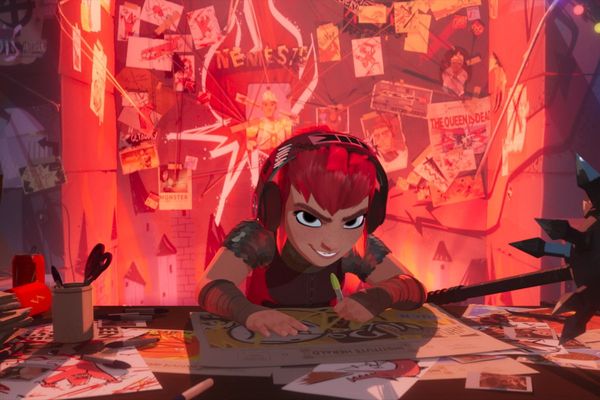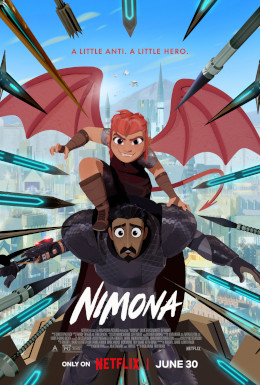Eye For Film >> Movies >> Nimona (2023) Film Review
Nimona
Reviewed by: Jennie Kermode

Who or what is Nimona (Chloë Grace Moretz)? A pink-haired girl, most commonly, but sometimes a boy. Sometimes a horse, a rhinoceros, a shark, a bat, a songbird. A shapeshifter who finds it hard to stay in one form, “like the feeling when you’re about to sneeze.” The one thing she has never really been is accepted.
Outsiders all too often come to define themselves by the terms applied to them by others. Dubbed a monster, Nimona has been looking for a role in life which fits that description, and as she has no real urge to be villainous herself – beyond a bit of entertaining destruction – she has set her heart on becoming a villain’s sidekick. An opportunity seems to arise when the first commoner ever to be made a knight of the city, Sir Ballister Boldheart (Riz Ahmed), appears to murder the queen live on television. But Ballister isn’t really a villain – he was set up – and when Nimona insists on sticking by his side, she finds herself going through an unexpected change.

Based on the Eisner Award-winning graphic novel by ND Stevenson, and Oscar-nominated for the computer-generated 3D animation which brings that imagery to life, this film explores a world in which feudal tradition clings on despite the presence of futuristic technology. There’s a supreme authority run by an obviously evil director (Frances Conroy) whom nobody dares to question, and the cowed citizens are happy to conform in exchange for protection from the dangers they are told lurk outside the city walls. Brash and free-thinking, Nimona instinctively challenges these received ideas, but they are not central to the story – which is fortunate, overfamiliar as they are. Instead we focus on Ballister’s attempts to clear his name, his complicated relationship with boyfriend Ambrosious Goldenloin (Eugene Lee Yang) – who believes him to be a traitor – and the bond he gradually forms with Nimona.
There’s a strong queer theme throughout. Nobody seems to have taken issue with Ballister and Ambrosius’ relationship, bland and unthreatening as it is, but hostility towards Nimona centres in large part on the challenge she poses to order by her very nature – by her inability to fit into any category other than that of monster. Young neurodivergent people, as well as LGBTQ+ people, will find a lot to relate to. Beyond that, however, the film doesn’t have a great deal of depth, and neither do the characters. We never get a real sense of who Nimona is as an individual, beyond the impressions she gives to other people, so that the film comes to rely on the old trope of eliciting sympathy for a monster rather than de-monstering her. Ballister is naïve and finds himself torn in different directions in a way that is par for the course for adults in such stories, whilst Ambrosius is so persistently dim that it’s hard to see what the two men were doing together.
In addition to this, the film gives Nimona far too much power. She’s insecure, of course, and that generates moments of pathos towards the end, but it’s all too quickly established that she can get herself and her ‘boss’ out of pretty much any perilous situation, which destroys the tension. The shapeshifting theme is used to explore the pertinent issues of fake news and post-truth culture, but this is done so feebly that even the youngest audience members are unlikely to be impressed.
Overall, there’s a sense that the film is working hard to bind itself, in structure and in tone, to the Disney influences behind its backdrops, whilst at the same time trying to be punk (Christophe Beck delivers a thrash metal score with contributions from the Sex Pistols’ Steve Jones, and there’s a focus on graffiti and piercings). The effect is reminiscent of a middle aged dad trying to be cool at a tweenager’s party. Nimona herself at least seems to be aware that she can’t be everything at once. The film tries, and in so doing, fails to develop a personality of its own.
Reviewed on: 10 Feb 2024
















